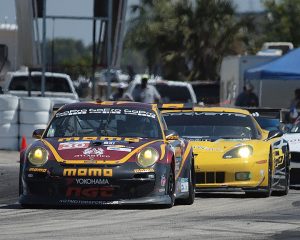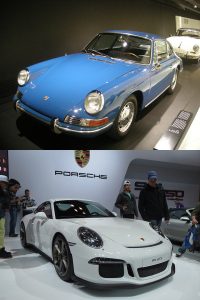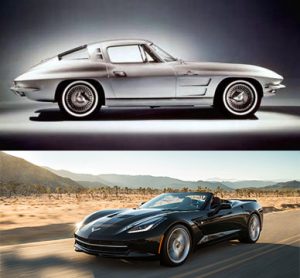 No two icons of high performance automobilia could be as different as the Porsche 911 and Chevy Corvette. Each has evolved to epitomize the best of American and European engineering, despite representing traditionally opposite views on design architecture. So I wonder, which car or performance philosophy is your favorite – and why?
No two icons of high performance automobilia could be as different as the Porsche 911 and Chevy Corvette. Each has evolved to epitomize the best of American and European engineering, despite representing traditionally opposite views on design architecture. So I wonder, which car or performance philosophy is your favorite – and why?
This blog started when Dan Erickson, Pat Johnson and I were at the office talking about Dan’s recent experiences at Firebird Raceway, where he was giving one-on-one driving lessons from the passenger seat of a Porsche GT3 911. He mentioned it was another fun, safe Pro Auto event weekend with only a handful of incidents, mostly Corvettes missing turns, apparently a relatively common occurrence.
Dan shared how completely different Corvettes and Porsche 911’s race, with each car requiring a unique driving skillset to achieve maximum on-track performance. He’s driven both and said to go fast you have to keep the cars balanced.
The just don’t balance the same way.
 The Porsche remains a rear engine, RWD thoroughbred that loves the turns and twisties; the Corvette is still the same high-horsepower, front engine, RWD sports car built for acceleration and speed.
The Porsche remains a rear engine, RWD thoroughbred that loves the turns and twisties; the Corvette is still the same high-horsepower, front engine, RWD sports car built for acceleration and speed.
These are the two most popular sports cars among fans inquiring about Attesa. They represent more than five decades of truly great racing history, from design philosophies an ocean apart.
Ferdinand Porsche drew up Germany’s people’s car in 1933, which became the Volkswagen Beetle in 1945. Ferry then started his own company with the Porsche 356, road-certifying his first 4-cylinder, 4-speed sports car in 1948, still using a swing axle rear suspension and torsion bar front end.
In 1963 Porsche introduced the 911 with independent suspension and a new 6-cylinder engine mated to a 5-speed. From 1967 through the early 70’s Porsche ruled European Rallycross and then turned its focus to road racing. Its most recent fame has come from building some all-conquering prototypes for Le Mans but the 911 is still the heart and soul of Porsche.
 Harley Earl conceived the first Corvette in 1952, entrusting Chevrolet GM Tom Keating to build a production version in 1953, powered by a straight-six and two-speed automatic. In 1955, after Zora Arkus-Duntov joined the team, the Corvette got a small-block V8 and a four-speed and went racing. With legendary success.
Harley Earl conceived the first Corvette in 1952, entrusting Chevrolet GM Tom Keating to build a production version in 1953, powered by a straight-six and two-speed automatic. In 1955, after Zora Arkus-Duntov joined the team, the Corvette got a small-block V8 and a four-speed and went racing. With legendary success.
Both companies continued to develop and improve their flagship performance models. Today’s 911 and CS7 still represent two different paths to the same destination.
Each car has its loyalists, most of whom respect and admire their brethren ‘on the other side of the aisle.’ Some find cruel pleasure in demeaning their opposition (911’s are for white wine and cheese -loving elitists, Corvettes are for mid-life-crisis men who need to compensate for certain shortcomings) for no reason other than fierce tribalism.
Dan has a lot of experience in Porsche, Chevy, Ferrari and other high-performance sports cars, plus open wheel race cars. It wasn’t a dig when he talked about how easy it is to spin a Corvette, just confirmation of how only the very best drivers can wring maximum entry, corner and exit speed out of one.
He particularly has a lot of respect for multi -Le Mans and Daytona class winner Jan Magnussen, perhaps Corvette Racing’s best driver, especially after watching his ‘incident’ at Laguna Seca in 2009, while trying to pass a Porsche. No risk it, no biscuit.
Aside: Somehow our conversation shifted to the Chevy Corvair, GM’s first answer to the European (BMW, Fiat, Renault, VW) and Japanese (Datsun and Toyota) import car invasion, featuring a horizontally-opposed, aluminum block, air-cooled engine situated behind the rear axle.
Introduced in 1960 the Corvair was slowly being improved and finding a market until the Mustang was introduced, prompting Chevy to shift its focus to creating the new Camaro. Next, attorney and political activist Ralph Nader published a book called Unsafe at Any Speed, demonizing the American auto industry and using the killer Corvair as his scariest case study.
By 1965, when Nader’s book came out, the Corvair had been upgraded with fully independent suspension, a more powerful turbocharged engine, new styling. The car magazines were giving it rave reviews. No matter, the car’s reputation was ruined. A muscled, bigger-is-better American version of Stuttgart’s finest was abandoned with production ending in 1969.
Last thoughts: In 2017 Ford introduced its mid-engine Ford GT while Porsche introduced a mid-engine 911 RSR, specifically designed to beat the Corvettes in WEC and IMSA competition. There are spy shots of the supposed all-new, mid-engine Vette but nothing’s been announced. Have no doubt, though; if abandoning the original drivetrain layout is necessary to keep Corvette out front, it will be done.
And there will always be a Porsche vs Corvette rivalry.
